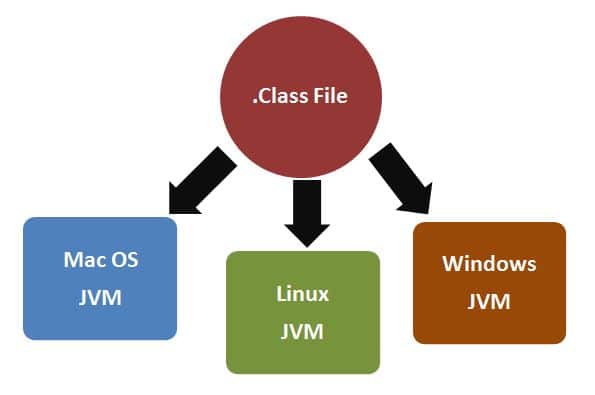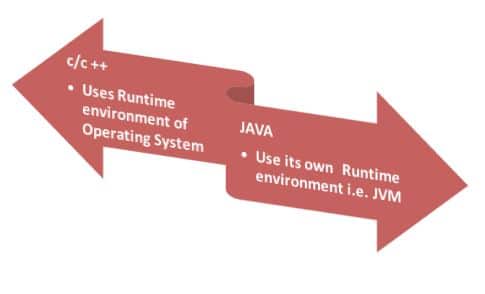Page Contents
Features of Java
The main purpose of creating the Java programming language was to make it portable, simple, and secure. In addition to this, there are some great features that play an important role in the popularity of this language and those are:

Simple
Java is a simple programming language.It removes some of the complicated concepts such as:
- Java doesn’t support complex concepts like pointers, operator overloading, so Java programs work as fast and its required less development time.
- Java has added the concept of garbage collation to destroy unnecessary objects automatically that free up memory.
- It provides user-friendly syntax which is based on C++
Object-oriented
Java is an object-oriented programming language. Everything in Java is an object. Object-oriented means organizing software as a combination of different types of objects and classes. Objects are entities that contains both data and behavior, and classes are the blueprints from which objects of similar types are created.
Read this article to see some basic Object Oriented Programming questions.
Platform Independent

In java, we can execute Java code on multiple platforms such as Windows, Linux, Android OS, Mac/OS, etc., so it is platform independent compared to other languages such as C, C++. Java provides a software-based platform. The Java code is compiled by the compiler and converted to .class file which is also called bytecode.
This bytecode is platform-independent code that is interpreted by the Java Virtual Machine (JVM).
Secured
Java is best known for its security. You can use Java to develop virus-free systems. Java is safe because it runs in a virtual machine.
There are several other reasons to make Java secure and those are:

- ClassLoader: The Java Class Loader is part of the Java Runtime Environment (JRE) used to dynamically load Java classes into the Java Virtual Machine. You can enhance security by separating the classes of local file system using package .
- Java security model: Java’s security model aims to protect users from malicious programs downloaded from untrusted resources on the network via sandboxes. It allows all Java programs to run only in the sandbox, prevents many actions from untrusted resources.
- No use of pointers: C/C ++ uses pointers, which can lead to unauthorized access to blocks of memory if another program obtains the pointer’s value. Unlike traditional C/C ++ languages, Java does not use any pointers. Java has an internal mechanism for memory management. Allow a program to access data only if it is a properly validated statement.
- Exception Handling Mechanism: The concept of exception handling allows Java to capture many bugs that help developers eliminate the risk of a system crash.
- Bytecode is another element that makes Java safer: Every time a user compiles a Java program, the Java compiler will generate a bytecode class file and the JVM will check for viruses and other dangerous files while the program is running.
- Security Attack Protection: Developers can declare a class or method FINAL. Everyone knows that a class or method declared as final cannot be overridden. This allows developers to protect their code from security attacks such as creating subclasses and replacing them with the original class and override methods.
Robust
Java is robust in the sense that Java places a lot of emphasis on checking for possible bugs in a timely manner, since Java compilers can detect many problems that would occur at runtime in other languages. Java has a powerful memory allocation and automatic garbage collection mechanisms. It provides the strong exception checking and type checking mechanism compared to other programming languages. The compiler checks for errors in the program and the interpreter checks for errors at runtime and makes the system safe from failures and java uses strong memory management. All of the above features make the Java language robust.
Architecture-neutral
The Java compiler produces an architecture-independent object file format. This allows the compiled code to run on many processors in the presence of the Java Runtime System. Java is architecture-independent, as there are no implementation-dependent features such as the size of primitive types is fixed.
Portable
Java is portable because it is architecture independent and has no implementation dependent aspects of the specification
“Java is portable” refers to the SE version. It means you can run Java bytecode on any hardware that has a compatible JVM.
High-performance
At run time, JVM loads the class files and performs the appropriate computation.
Java enabled High performance by introducing the JIT-Just In Time compiler, JIT helps the compiler to compile the code on demand i.e any method that calls only that block of methods will be compiled making the compilation fast and efficient over time. This causes Java to offer high performance.
Distributed
Java is distributed because it makes it easy for users to create distributed applications in Java. RMI and EJB are used to create distributed applications. This Java function allows us to access files by calling methods from any machine on the Internet.
It compiled on one machine can be easily transferred to the machine and run on another computer because the bytecode function is therefore Java is specifically designed for internet users .
Multi-threaded
With the multi-threaded Java functionality, it is possible to write programs that can do many tasks simultaneously.We can execute several tasks simultaneously where each task is separate independent part of the same program as a thread.The main advantage of multi-threading is that it doesn’t take up memory for each thread. Share the same memory area.
Dynamic
Java is considered more dynamic than C or C ++ because it is designed to adapt to an evolving environment.
This supports dynamic class loading. This means that the class is loaded on demand.
It supports dynamic compilation and automatic memory management through garbage collection